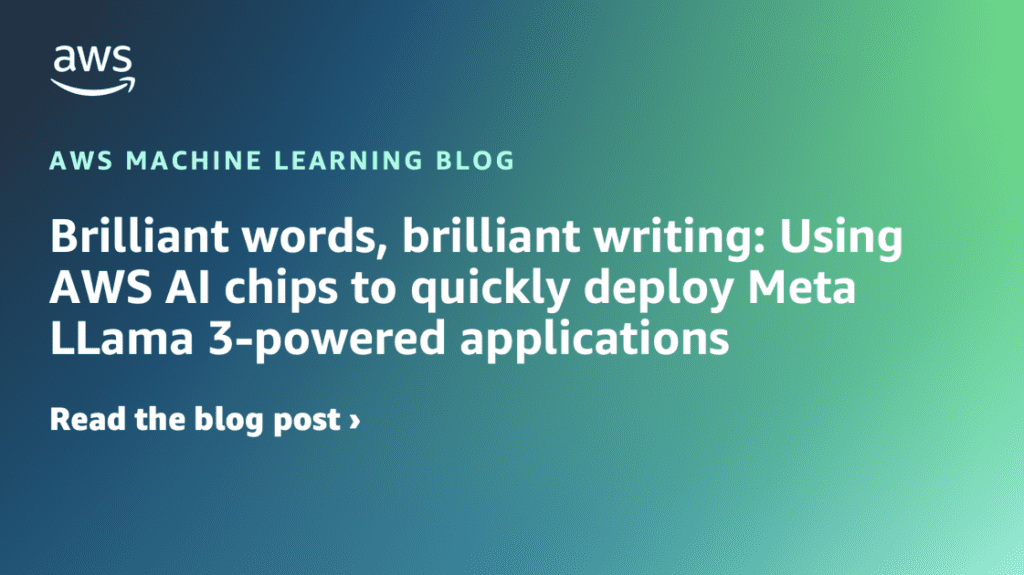Unleashing the Power of Large Language Models on AWS: A Cost-Effective Approach
As the landscape of artificial intelligence evolves, organizations are increasingly gravitating toward generative AI applications powered by large language models (LLMs) like Llama and Mistral. These highly complex models hold the key to boosting productivity and delivering unique experiences. However, with great power comes great cost—deploying these LLMs often requires robust computing resources that can strain budgets and resources, especially for smaller businesses or academic researchers.
In a world where high inference costs act as a barrier to entry, there’s a pressing need for more efficient and budget-friendly solutions. Many generative AI applications necessitate human interaction, which demands AI accelerators capable of providing real-time responses with minimal latency. Additionally, the rapid pace of innovation in this space makes it increasingly challenging for developers and researchers to keep up and adopt new models swiftly.
A Way Forward: Amazon Bedrock and EC2 Inf2 Instances
To help overcome these hurdles, organizations can explore tools like Amazon Bedrock, particularly if they want to kickstart their journey with LLMs. For businesses seeking increased control over their deployment environments, the option to utilize LLMs fine-tuned for AWS Inferentia2 on Amazon Elastic Compute Cloud (Amazon EC2) Inf2 instances proves invaluable.
In this article, we’ll delve into a solution that employs EC2 Inf2 instances to deploy multiple industry-leading LLMs efficiently, allowing users to benchmark performance and utilize APIs effectively.
Model Spotlight: A Brief Overview
We’ll examine three popular models that demonstrate diverse capabilities and use cases:
-
Meta-Llama-3-8B-Instruct
- Developed by: Meta
- Parameters: 8 billion
- Released: April 2024
- Capabilities: Language understanding, translation, coding, inference, and chat.
-
Mistral-7B-instruct-v0.2
- Developed by: Mistral AI
- Parameters: 7.3 billion
- Released: March 2024
- Capabilities: Language understanding, translation, coding, inference, and chat.
- CodeLlama-7b-instruct-hf
- Developed by: Meta
- Parameters: 7 billion
- Released: August 2023
- Capabilities: Code generation, code completion, and chat.
The Meta-Llama-3 model is particularly noteworthy. With breakthroughs in pre-training and enhanced skills across various tasks, the Meta AI team positions it as a catalyst for future AI innovations. The Mistral model is another promising entry, setting a new standard in user-friendly and powerful AI tools. Lastly, Code Llama targets developers specifically, assisting them in coding tasks and serving as both a productivity and educational resource.
Solution Architecture: Client-Server Made Easy
This solution employs a streamlined client-server architecture. On the client side, users can access a chat interface built using HuggingFace’s Chat UI, compatible with both PCs and mobile devices. The server utilizes Hugging Face’s Text Generation Inference for efficient model inference executed within a Docker container.
Key Features of the Solution:
- Multiple Models on One Instance: All components are hosted on an Inf2 instance, enabling users to experience the effects of different models simultaneously.
- Flexibility: Users can switch either the client or server side deployment based on their specific needs.
- API Access: Quick access via an API interface allows users to engage seamlessly with the models.
Main Components
Several integral components make this solution robust:
- Hugging Face Optimum Neuron: This interface allows for efficient model loading, training, and inference, tailored for AWS hardware.
- Text Generation Inference (TGI): This high-performance framework serves popular LLMs, providing an easy way for users to generate and stream text.
- HuggingFace Chat UI: This open-source chat tool can be easily customized and integrated with backend services, enabling smooth interactions with LLMs.
Solution Deployment Steps
To get started, ensure you have an inf2.xl or inf2.8xl instance quota within the AWS us-east-1 or us-west-2 regions. Once set up, follow these steps for deployment:
- Access the AWS Management Console and navigate to CloudFormation.
- Choose “Create Stack” and enter the necessary parameters, including the Amazon S3 URL of the template.
- Select your desired instance type and configure settings.
- Submit to create the stack and wait for the resources to spin up—about 15 minutes on average.
After deployment, users can interact with the solution through a provided URL, and switch between models as needed—all from a user-friendly interface.
API Access and Performance Testing
The deployed solution offers various API interfaces, including /generate and /generate_stream, streamlining processing and enhancing user experience. Users can effortlessly make API calls to generate responses or stream tokens based on their requirements.
Example API request using cURL:
curl -X POST \
http://<your-instance-ip>:8080/generate \
-H "Content-Type: application/json" \
-d '{"inputs": "Calculate the distance from Beijing to Shanghai"}'Conclusion: Embrace the Future of AI
Throughout this article, we explored how to harness the capabilities of leading LLMs like Meta-Llama-3 and Mistral on AWS platforms, enhancing productivity and innovation. By leveraging the EC2 Inf2 instances, users can unlock the full potential of these technologies without breaking the bank. As AWS continues to expand its offerings, the door is open for countless possibilities in deploying AI solutions.
The AI Buzz Hub team is excited to see where these breakthroughs take us. Want to stay in the loop on all things AI? Subscribe to our newsletter or share this article with your fellow enthusiasts.




